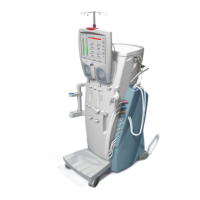10. Blood Pump
10.5 BP CONTROL AND POWER
The purpose of the Blood Pump Controller Board is to provide the
control signals to the Blood Pump Power Board to operate the
blood pumps.
The blood pump control system essentially consists of the BP
Controller Board and BP Power Board. The BP Controller Board
receives regulated +5 V, +12 V and -12 V through the Passive
Backplane. The BP Power Board in turn receives those voltages
from the BP Controller via the ribbon cable. The +24 V power is
delivered to the BP Power Board from the +24 V unregulated
power supply. Refer to Section 5.4.4 for the location and
configuration of the BP Controller Board.
Figure 10-6 is a block diagram of the blood pump control system.
Refer also to the Arena Interconnect Diagram (157-1278-586) at
the end of Section 5, Electronic Theory.
The operator enters the desired blood pump rate information on the
video display touch panel. The SBC converts this information to
the appropriate motor rate which it then sends to the Blood Pump
Controller Board. The Blood Pump Controller Board converts the
motor rate information to an analog level and feeds the information
to a motor speed controller on the Blood Pump Power Board.
An optical speed (tach) sensor is mounted on the rear shaft of the
blood pump motor (Figure 10-1), with an LED on one side of the
shaft, and a photo transistor on the opposite side. The shaft has
two holes drilled through it. Each hole is perpendicular to the
shaft and to the other hole. When the blood pump is rotating, four
optical pulses are received per shaft revolution.
This tachometer signal is monitored by both the Blood Pump
Power Board and the Blood Pump Controller Board. The Blood
Pump Power Board provides quick-responding speed control by
comparing the motor speed with the desired speed information
from the Blood Pump Controller Board. The result of this
comparison is an error signal which provides an input to the motor
power driver circuit.
The Blood Pump Power Board provides a +24 V pulse width
modulated drive to the motor at a frequency of approximately 30
kHz. This drive is current limit protected to prevent damage in the
event of a stalled motor.
157-1278-917 Rev A 10-9
April 2004

